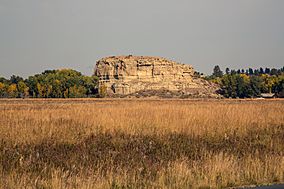Pompeys Pillar National Monument facts for kids
Quick facts for kids Pompeys Pillar National Monument |
|
|---|---|
 |
|
| Location | Yellowstone County, Montana, USA |
| Nearest city | Billings, MT |
| Area | 51 acres (21 ha) |
| Established | January 17, 1806 |
| Visitors | 50,000 (in 2002) |
| Governing body | U.S. Bureau of Land Management |
| Website | Pompeys Pillar National Monument |
Pompeys Pillar National Monument is a special rock formation located in south-central Montana, USA. It was named a National Monument on January 17, 2001. The U.S. Bureau of Land Management takes care of it. This monument is quite small, only 51 acres. This makes it one of the smallest National Monuments in the U.S. Before becoming a National Monument, it was named a National Historic Landmark in 1965.
A new visitor center opened at Pompeys Pillar in 2006. This center has exhibits that tell the story of Captain William Clark's journey. In 1806, he traveled down the Yellowstone River Valley. His group included Sacagawea and her son, Pomp.
Contents
About Pompeys Pillar
A Special Rock Formation
The pillar itself is 150 feet (about 45 meters) tall. It stands high above the Yellowstone River. This rock is made of sandstone. It formed a very long time ago, between 75 and 66 million years ago. This was during the late Cretaceous period. The bottom of the pillar covers about 1 acre of land.
Clark's Famous Mark
The pillar has many ancient carvings made by Native American people. These are called petroglyphs. It also has the signature of William Clark, who was a co-leader of the famous Lewis and Clark Expedition. Clark's signature is the only physical proof of the expedition found along their entire route.
Clark wrote his signature and the date, July 25, 1806, on the rock. He wrote that he climbed the sandstone pillar. From the top, he said he had "a most extensive view in every direction on the Northerly Side of the river." He named the rock after Jean Baptiste Charbonneau. Jean Baptiste was Sacagawea's son, and Clark called him "Pompy." Clark first named it "Pompys Tower," but the name was changed to Pompeys Pillar in 1814.
Ancient History and Visitors
Pompeys Pillar is located about 25 miles (40 km) northeast of Billings, Montana. You can find it along Interstate 94. About 50,000 people visit the pillar every year.
Archeological findings show that people have been visiting this rock for about 11,000 years. Because of this long history, many people have carved their initials into the rock. This includes early pioneers who came to the area, in addition to the Native American carvings and William Clark's signature.
Images for kids




